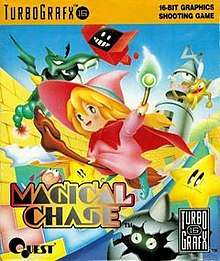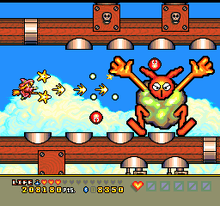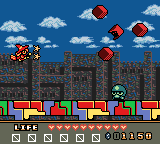Magical Chase
Magical Chase[lower-alpha 2] is a scrolling shooter video game developed by Quest and released by Palsoft for the PC Engine in Japan in 1991. The game was graphically altered for its North American release in 1993 on the TurboGrafx-16. It was later ported for Windows in 1998, and for the Game Boy Color in 2000.
| Magical Chase | |
|---|---|
 North American TurboGrafx-16 cover art | |
| Developer(s) | Quest[lower-alpha 1] |
| Publisher(s) | TurboGrafx-16 Bothtec (Windows) Microcabin (GBC) |
| Director(s) | Hiroshi Minagawa |
| Designer(s) | Hiroshi Minagawa |
| Programmer(s) | M. Ogawa |
| Artist(s) | Hiroshi Minagawa |
| Composer(s) | Hitoshi Sakimoto Masaharu Iwata |
| Platform(s) | Game Boy Color Microsoft Windows TurboGrafx-16 |
| Release | TurboGrafx-16 Windows
|
| Genre(s) | Horizontally scrolling shooter |
| Mode(s) | Single-player |
Gameplay

Magical Chase is a horizontally scrolling shooting game.[1] The stars serve as Gradius-style options.
The game has been compared to Cotton: Fantastic Night Dreams, as they both feature young witch characters who ride broomsticks, are of the same genre of shooting games, and were released for the PC-Engine in a similar time frame.[2][3]
There are a total of six levels in the game which can be played on the normal and hard difficulty settings. Only the first three can be played on the easy difficulty setting. As enemies are destroyed, they leave behind different colored gemstones which serve as the game's currency. Twice during each level, a shop appears where power-ups, health, and extra lives can be purchased (except for the third and sixth levels, where it only appears once).
Touching obstacles and the ground does not kill the player such as in Gradius but it does impede progress. If the player gets trapped behind objects at the left-hand side of the screen, "scrolling damage" will occur. Each stage is presented with the name of the mid-boss encountered, and keeping with the magic theme, is titled as a magical seal. Each level has a mid-boss and end-boss.
Plot
The game stars a young witch named Ripple[4], an apprentice to a terrifying witch. Ripple has just broken a promise she made to the witch and took a peek inside a forbidden book, freeing six demons. Unless she can catch all six and get them back inside the book, the witch will turn Ripple into a frog. Ripple sets off on her quest with her two Elf-Star friends, known as "Star Maidens": Topsy and Turvy.
Development
The game was developed by Quest, and the team that made it would later go on to work on Ogre Battle, Tactics Ogre, and Final Fantasy Tactics.[5] Hiroshi Minagawa is credited with Art Direction and Game Design for this game.[6]
The game features parallax scrolling, which is done by using several traditional technics: horizontal split-screen, animated tile mapping and layered sprites.
The North American release has different graphics than the original Japanese release, such as the graphics on the first level.[4]
Release

Magical Chase was originally released for the PC Engine in Japan on November 15, 1991.[7] Magical Chase was a bestselling game on the PC Engine in Japan during late 1991 and early 1992.[8][9]
Its late 1993 release in the U.S. at the end of the TurboGrafx's life, coupled with extensive hype and only being available through a mail order, makes the game harder to find and more expensive than earlier releases.[10] Some sprites and the entire first stage were extensively modified in the U.S. version.[4] The game has since gone onto become a rare collector's item that fares high prices on the resale market.[11][12]
The first port of Magical Chase to appear outside the NEC console family was a Windows 95 port released on April 10, 1998.[13] Magical Chase was later ported to the Game Boy Color by Micro Cabin and released in Japan on August 4, 2000.[14]
The IP is currently owned by Square Enix, as per their buyout of Quest in 2002.[15]
Reception
| Reception | ||||||||||||||||||||
|---|---|---|---|---|---|---|---|---|---|---|---|---|---|---|---|---|---|---|---|---|
| ||||||||||||||||||||
Upon release, Famitsu gave the game a score of 26 out of 40. Reviewers noted the game incorporated elements from R-Type, Super Mario World, and Fantasy Zone.[7]
Four reviewers for Electronic Gaming Monthly all gave the game scores of 7/10.[21] Italian magazine Consolemania gave it a score of 90/100.[22]
Video Games & Computer Entertainment praised the game giving it 7/10 score.[23]
Famitsu gave the Game Boy Color version a score of 23/40.[14]
In 2008, IGN's Lucas M. Thomas included both Cotton and Magical Chase ("two different games, one same idea") at number four among the top ten "unreleased TurboGrafx games" for the Wii Virtual Console.[2]
In 2008, Retro Gamer placed the game on at number 10 on its top 10 list of PC Engine games. They said that past the cute visuals, the game is a solid shooting game.[4]
Hardcore Gamer praised the game's use of parallax scrolling as a technical feat that places it far above other games for the PC-Engine.[24]
Notes
References
- "The Turbo Tech Lineup". GamePro. No. 38. September 1992. p. 106.
- Thomas, Lucas (2008-10-17). "Retro Remix: Top 10 Unreleased TurboGrafx Titles". IGN. Archived from the original on 2016-08-20. Retrieved 2019-05-23.
- "Daily Classic: With Cotton, TG-16 Shooters Got Adorable". USgamer. Archived from the original on 2016-10-08. Retrieved 2015-11-11.
- "PC EngineGT Perfect 10 Games". Retro Gamer. United Kingdom. May 2008. p. 57.
- "Gen32 Japansoft: Final Fantasy Tactics". Gamefan. Vol. 4 no. 10. October 1996. p. 111.
- "VAGRANT STORY : from the Development Team". web.archive.org. 2002-08-08. Archived from the original on 2002-08-08. Retrieved 2019-05-23.
- "マジカルチェイス [PCエンジン] / ファミ通.com". www.famitsu.com. Archived from the original on 2016-10-29. Retrieved 2019-05-23.
- "CVG Charts". Computer and Video Games. No. 122. United Kingdom. January 1992. p. 88.
- "CVG Charts". Computer and Video Games. No. 124. United Kingdom. March 1992. p. 75.
- Hashimoto, Shingi (2015-03-30). "秋葉原にレトロPC&ゲーム店『BEEP@秋葉原』オープン。レトロゲーム関連基板や雑誌、グッズなどまで扱う総合店、海外ハードや名作試遊コーナーも - Engadget Japanese". Japanese.engadget.com. Archived from the original on 2015-11-05. Retrieved 2015-11-11.
- Massey, Tom (2015-01-25). "A guide to gaming's most valuable treasures". Eurogamer. Archived from the original on 2017-11-12. Retrieved 2019-05-23.
- Woger, Martin (2014-07-08). "Die wertvollsten, seltensten und teuersten Spiele für die PC-Engine / TurboGrafx". Eurogamer.de (in German). Retrieved 2019-05-28.
- "Magical Chase PC". web.archive.org. 2019-12-03. Retrieved 2019-12-04.
- "マジカルチェイスGB 〜見習い魔法使い 賢者の谷へ〜 [ゲームボーイ] / ファミ通.com". www.famitsu.com. Archived from the original on 2018-07-22. Retrieved 2019-05-23.
- "― STG「VECTROS」「マジカルチェイス」のサウンドトラックCDが2月26日に発売". 4gamer.net. 2013-01-16. Archived from the original on 2016-10-30. Retrieved 2015-11-11.
- "Magical Chase soundtrack is finally something you can own". Destructoid.com. 2013-03-20. Archived from the original on 2015-09-06. Retrieved 2015-11-11.
- "Magical Chase". Consoles +. No. 5. January 1992.
- "Magical Chase". Génération 4. No. 40. January 1991.
- "Magical Chase". Joypad. No. 4. January 1992.
- "Magical Chase". Joystick. No. 23. January 1992.
- Electronic Gaming Monthly 46 (May 1993). "Review Crew: Magical Chase". Electronic Gaming Monthly. No. 46. p. 32.
- "Magical Chase". Consolemania (in Italian). No. 4. Italy. January 1992. pp. 68–69.
- Mandel, Joshua (May 1993). "Video Game Reviews: Magical Chase". Video Games & Computer Entertainment. Vol. 5 no. 5. p. 54.
- Thomasson, Michael (December 2008). "Let's RetroGamer Holiday". Hardcore Gamer. Vol. 4 no. 4. Prima Games. p. 37.
External links
- Official website (Win) (in Japanese)
- Official website (GBC) (in Japanese)
- Magical Chase at MobyGames
- Magical Chase GB at GameFAQs